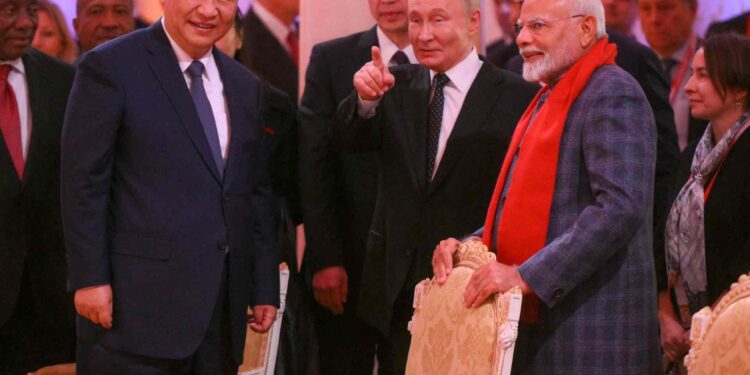Russian President Vladimir Putin proposed forming a list of partner countries of the BRICS group and confirming this in the final declaration of the ongoing Kazan summit of the bloc, after the number of its countries increased to 10 during the current year with the addition of Saudi Arabia, Egypt, the Emirates, Iran and Ethiopia.
Putin said – during a meeting with BRICS leaders on Wednesday – that it would be a mistake to ignore the unprecedented interest of the countries of the Global South and the East, adding that the members of the bloc enjoy enormous economic, scientific, demographic and political potential, according to what was reported by the Russian Sputnik agency.
The activities of the second day of the BRICS Summit 2024 have begun in Kazan, Russia, and a number of leaders, leaders and guests have arrived at the summit, which is being held today in an expanded manner.
For his part, Russian Presidential Assistant Yuri Ushakov confirmed that 13 countries had applied to obtain the status of a “partner country” of the BRICS group.
“This is the subject of consultations between delegations of our countries, and then all this will be studied by the leaders. Now, let’s be honest, there are 13 countries demanding the status of partner countries in BRICS,” Putin’s aide said.
Peak concentration
The summit, with the main title “BRICS and the Global South to Jointly Build a Better World,” focuses on food security and energy issues, with special attention to the Middle East.
36 countries participate in it, including 22 at the highest level and leaders of 6 international organizations, discussing issues of interaction between the countries of the global majority, in resolving urgent crises, including improving the structure of international relations, and ensuring sustainable development of food and energy security, in addition to the deteriorating situation in the Middle East.
At the forefront of the activities – scheduled to end tomorrow – is the idea of getting rid of the dollar in intra-bloc transactions, especially with the increase in US sanctions on Russia since the start of the war in Ukraine, one of the pillars of which was the US control over global payment and money transfer systems.
It is noteworthy that although central banks have worked to diversify their holdings, including gold, about 58% of foreign exchange reserves are in dollars, and the effects of the dollar network place American banks at the center of global payment systems.
All banks deal in dollars through a correspondent bank in America, which enables the country issuing the “green” currency to monitor flows for signs of financing what they call “terrorism” and evade sanctions.
Gradual action
International economist Dr. Karim Al-Omda was quoted as saying that switching to a new payment mechanism between countries is not an easy measure, but it will be gradual and will require time, as countries move in this direction.
The mayor said, “China and Russia have already begun the process of reducing dependence on the dollar due to its importance in international transactions, which gives the United States additional strength.”
He described the dollar as not just a means of trade exchange, “but rather an American hegemony,” saying that mutual investments between the BRICS countries will enhance the group’s presence, noting the experience of payments away from the dollar between Brazil and Argentina, in addition to the experience of dealing in local currencies between the UAE, India, Russia, and China, especially the energy sector.
The British newspaper The Economist reported that the “BRICS Bridge” payment system according to the Russian name is scheduled to be built within a year, which will allow countries to conduct cross-border settlement using digital platforms managed by their central banks.
According to the Economist, the new BRICS plan, which focuses on digital currencies run by central banks, appears to be at least partly inspired by an experimental payments platform called “M Bridge” that was developed by the Bank for International Settlements along with the central banks of China, Hong Kong, Thailand, the Emirates and Saudi Arabia. , in addition to 31 other observer members.
In another economic context, during his meeting with Dilma Rousseff, President of the New Development Bank of BRICS, the Russian President described it as a promising financial institution, noting that the bank has financed projects worth $33 billion since 2018.



